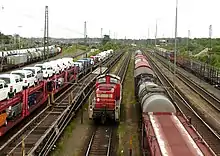Rolling stock
The term rolling stock in the rail transport industry refers to railway vehicles, including both powered and unpowered vehicles, for example locomotives, railroad cars, coaches, private railroad cars and wagons.[1][2][3][4] A connected series of railway vehicles is a train.

In the United States, the definition has been expanded from the older broadly defined "trains" to include wheeled vehicles used by businesses on roadways.[5][6][7]
Overview
The word "stock" in the term is used in a sense of inventory. Rolling stock is considered to be a liquid asset, or close to it, since the value of the vehicle can be readily estimated and then shipped to the buyer without much cost or delay.[8][9] The term contrasts with fixed stock (infrastructure), which is a collective term for the track, signals, stations, other buildings, electric wires, etc., necessary to operate a railway.


 DMU rolling stock
DMU rolling stock
 American-style hopper car
American-style hopper car Articulated well cars with intermodal containers
Articulated well cars with intermodal containers
 European-type covered freight cars
European-type covered freight cars
Code names
In Great Britain, types of rolling stock were given code names, often of animals. For example, "Toad" was used as a code name for the Great Western Railway goods brake van,[10] while British Railways wagons used for track maintenance were named after fish, such as "Dogfish" for a ballast hopper.[11] These codes were telegraphese, somewhat analogous to the SMS language of today.
See also
References
- "Yaxham Light Railway rolling stock page".
- "Definition of "rolling stock" from the Oxford English Dictionary accessed 5 February 2007 (subscription service)".
- "Definition of "rolling stock" from the Concise Oxford Dictionary".
- "Definition from the American Heritage Dictionary". Archived from the original on 2009-02-22.
- "rolling stock". The Free Dictionary. Farlex. Retrieved January 27, 2017.
- Illinois Department of Revenue. "RUT-7: Rolling Stock Certification" (PDF). Retrieved January 27, 2017.
- "Michigan's Rolling Stock Exemption". TaxRates. Avalara. Retrieved January 27, 2017.
- Finger, Matthias; Bert, Nadia; Kupfer, David, eds. (2014). "Rail infrastructure and rolling stock: investments, asset renewal and regulation" (PDF). European University Institute, Florence School of Regulation. pp. 8–9.
- Wijnia, Y.; de Croon, J.; Liyanage, J.P. (2014). "36: Application of a Unified Reference Model Across Asset Types: Comparative Cases". In Lee, Jay; Ni, Jun; Sarangapani, Jagnathan; Mathew, Joseph (eds.). Engineering Asset Management 2011: Proceedings of the Sixth World Congress on Engineering Asset Management. London: Springer. pp. 416–417. ISBN 978-1-4471-4993-4. ISSN 2195-4356. LCCN 2013934026 – via Google Books.
- "Code Names for Great Western Carriage Stock and Vans". greatwestern.org.uk.
- "Fishkinds and TOPS". btinternet.com. Archived from the original on 11 October 2012.
External links
![]() Media related to rail vehicles at Wikimedia Commons
Media related to rail vehicles at Wikimedia Commons
 The dictionary definition of rolling stock at Wiktionary
The dictionary definition of rolling stock at Wiktionary